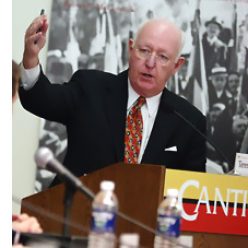The beleaguered, diminished editorial staff of The Annapolis Capital Gazette – a daily so old that it printed the Declaration of Independence – observed Labor Day with a cavalcade and rally protesting the decision of its publisher, The Tribune Company, to close its newsroom permanently.
“A Car is Not a Newsroom,” read one reporter’s sign, “We deserve better,” read another, “Save Local News” was a third.
“We’re not leaving without a fight,” said Selene San Felice, a Capital reporter, out on the street in front of her locked former office, conceding that there was no chance The Tribune Company would reverse its cost-conscious decision. Her concern, and that of other staffers, is that more cuts are coming.
When the Washington Post reported on the plans to close the newsrooms of the Capital and four other of Tribune’s local papers, the subhead asked an intriguing question: “What’s a Newspaper without a Newsroom?”
The Post piece noted that, in addition to The Tribune, the financially troubled McClatchy Company “took steps to close seven of its newspaper offices around the country.” Again, not temporarily because of the virus, but permanently.
The pattern is pretty hard to miss, and it certainly caught my eye. It was just the latest sign of the precipitous decline in advertising and revenue that has shuttered 2,100 newspapers across the country since 2005. It is also an example of the hard-headed, bottom line calculations imposed by the vulture capital firms that are acquiring and systematically bleeding the assets of scores of papers all over the country.
But still, the question: what is a newspaper without a newsroom?
In a nearly five-decade career in daily journalism I worked in three newspaper newsrooms and three network and public television newsrooms.
The first was a noisy, wooden-floored, high-ceilinged space on the second floor of The Stamford Advocate in Stamford, CT. There was a semi-circular news desk and the clatter of stand-up Remington typewriters.
The second and by far the most filthy and romantic, was the city room of The New York Herald Tribune on 41st Street. The vast room had no air conditioning, so the tall windows were left open night and day in the summer and the Manhattan grit crunched under your shoes as you arrived for work. But I loved it. And, look who labored at the desks near you: Tom Wolfe, Jimmy Breslin, Charles Portis and a dozen other rising stars. You didn’t have to look far for inspiration.
The third was the sprawling newsroom of The New York Times, an imposing, block-wide space between 43rd and 44th Street in those days, filled with Pulitzer winners, veteran shoe-leather reporters and cranky editors. David Halberstam was just back from the jungles of Vietnam, Gay Talese was on his way to a celebrated literary career and Harrison Salisbury was headed to Moscow. In the newsroom, your colleagues shared stories, gossip, advice and got your competitive and creative juices flowing.
The Washington and New York newsrooms of CBS News were filled in the 1980’s and ‘90’s with bold-faced names like Cronkite and Rather. They were mostly open, but a glass-walled section was called the NUB, short for Next Up Broadcast. The pace inside the NUB was intense, bordering on frantic, especially as 6:30 p.m. approached, broadcast time for the live CBS Evening News. A young producer, Susan Zirinsky, was a human whirlwind. Today, she is president of CBS News. Again, the newsroom was a place where you could share ideas and subject your own story proposals to critical review by your colleagues.
My final newsroom, the NewsHour with Jim Lehrer, now simply The PBS NewsHour, was, like the broadcast itself, more low key, measured and serious. The news mattered here, not ratings. It was housed in a dreary, two-story building in Shirlington, Va, just across the Potomac from Washington. The quarters were cramped, but we put on a reliable, responsible, hour-long newscast that reached a million or more discerning viewers each night. (The self-deprecating slogan among the staff: “We Dare to be Dull.” Today’s PBS NewsHour, with Judy Woodruff at the helm, is brighter and better.) Once again, the newsroom was the womb from which it all sprang.
The five soon-to-be-homeless Tribune papers are The Annapolis Capital Gazette, The Carroll County Times of Westminster, MD, The Morning Call of Allentown, PA, the Orlando Sentinel and, believe it or not, The New York Daily News.
The Daily News was once the largest circulation newspaper in the country, selling 2.4 million copies every day in the 1960’s. It’s newsroom in The News Building on E. 42nd Street had a huge globe dominating its lobby. It was so iconic, so clearly big time, it was used as the set of the Daily Planet in the Superman films. Today: The Daily News sells 200,000 copies on a good day and the newsroom is gone.
All these papers were the product of the collaboration, cooperation and inspiration that emerged from the collective creation of their newsrooms. Now they will all be permanently “remote,” emerging online from the homes and computers and cellphones of their staffers. Reporters will be filing from their cars.
Can it work? Absolutely. The Capital and and others have demonstrated that during the pandemic shutdown, working remotely and delivering first rate work to their readers. The extraordinary reporting of The New York Times and Washington Post on the Trump foibles of the last six months has all been done remotely.
Will it save the companies money? Of course.
Will it be the same – and as good? Absolutely not.
